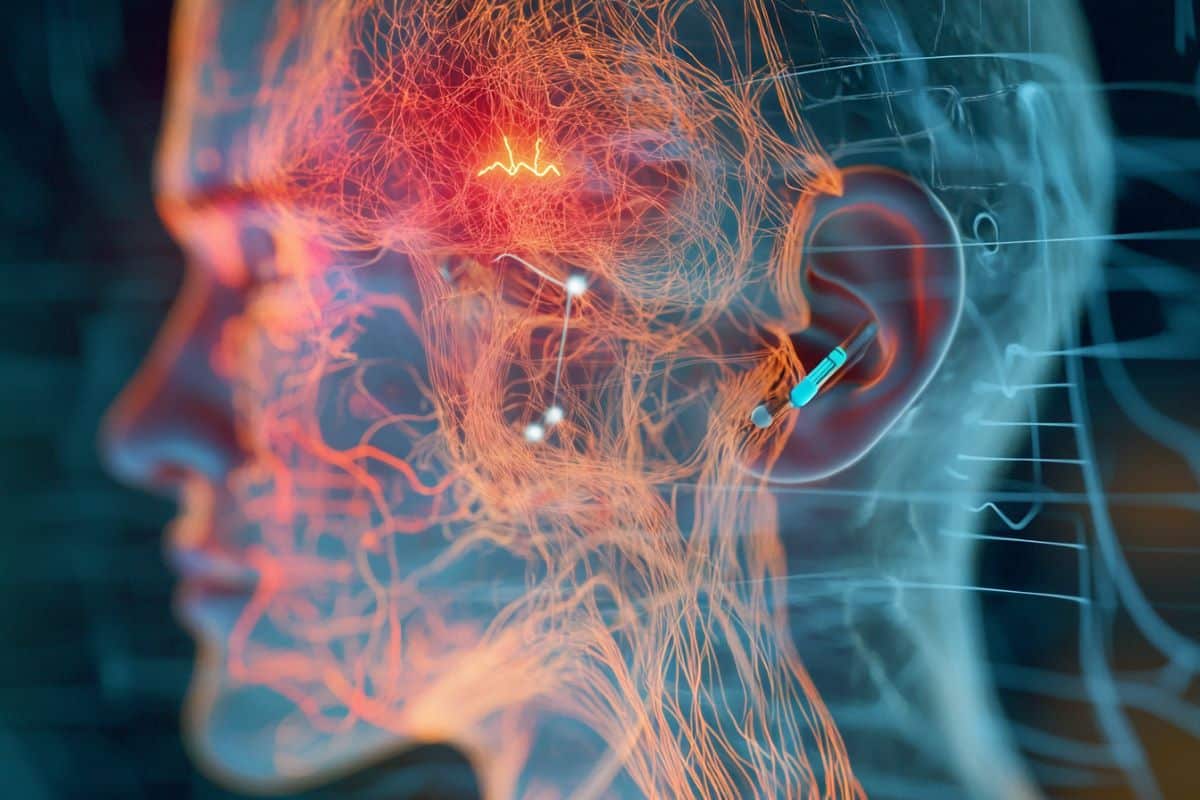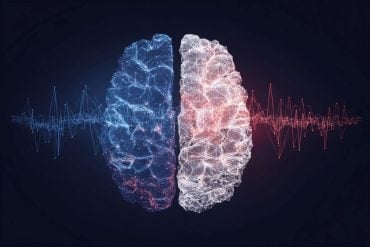Summary: Synchronizing vagus nerve stimulation with natural body rhythms, such as the heartbeat and breathing, significantly improves its effectiveness. This “electric pill” technique uses ear-mounted electrodes to stimulate the vagus nerve, targeting chronic conditions like pain and inflammation.
Researchers found that stimulation during heart contraction (systole) and inhalation phases produced the strongest results. The findings suggest that tailoring nerve stimulation to individual physiological rhythms could make this non-invasive therapy more effective, especially for patients who previously didn’t respond.
Key Facts:
- Timing Matters: Synchronizing stimulation with systole and inhalation enhances effectiveness.
- Customizable Therapy: Aligning stimulation with individual rhythms may improve treatment success.
- Non-Invasive Potential: Offers a targeted, gentle approach to chronic condition management.
Source: Vienna University of Technology
It doesn’t always have to be medication. Some health problems, from chronic pain and inflammation to neurological diseases, can also be treated by nerve stimulation, for example with the help of electrodes that are attached to the ear and activate the vagus nerve.
This method is sometimes referred to as an ‘electric pill’.

However, vagus nerve stimulation does not always work the way it is supposed to. A study conducted by TU Wien (Vienna) in cooperation with the Vienna Private Clinic now shows how this can be improved: Experiments demonstrate that the effect is very good when the electrical stimulation is synchronised with the body’s natural rhythms – the actual heartbeat and breathing.
The ‘electric pill’ for the parasympathetic nervous system
The vagus nerve plays an important role in our body: it is the longest nerve of the parasympathetic nervous system, the part of the nervous system that is significantly involved in the precise control of the internal organs and blood circulation, and is responsible for recovery and building up the body’s own reserves.
A branch of the vagus nerve also leads from the brain directly into the ear, which is why small electrodes in the ear can be used to activate the vagus nerve, stimulate the brain and thus influence various functions of the body.
“However, it turns out that this stimulation does not always produce the expected results,” says Prof Eugenijus Kaniusas from the Institute of Biomedical Electronics at TU Wien.
“The electrical stimulation does not have an effect on the nervous system at all times. You could say that the brain is just not always listening. It’s as if there is a gate to the control centre of the nervous system that is sometimes open and then closed again, and this can change in less than a second.“
Five people have now been examined in a pilot study. Their vagus nerve was electrically activated to lower their heart rate. It is already known from previous studies that heart rate is a potential indicator of whether stimulation therapy is beneficial or not.
It was shown that the temporal connection between the stimulation and the heartbeat plays a decisive role. If the vagus nerve is stimulated at a rhythm that is not synchronised with the heartbeat, hardly any effect can be observed.
However, if the stimulation signals are always applied when the heart is contracting (during systole), a strong effect can be observed – much stronger than if stimulation is applied during the relaxation phase of the heart, diastole.
Breathing is also important in this context: the stimulation was significantly more effective during the inhalation phase than during the exhalation phase.
“Our results show that synchronising vagus nerve stimulation with the heartbeat and breathing rhythm significantly increases effectiveness.
“This could help to improve the success of treatment for chronic illnesses, especially for those who have not previously responded to this therapy for reasons that are as yet unexplained,” says Eugenijus Kaniusas.
Larger clinical studies to follow
If nerve stimulation can be customised electronically so that it is tailored to the body’s own individual rhythms at any given time, it should be possible to achieve significantly greater successes than has been possible to date.
Future studies should examine larger and clinically relevant patient groups and develop even more precise algorithms in order to be able to tailor the stimulation even more precisely to individual needs.
“This technology could be an effective and non-invasive way of modulating the autonomic nervous system in a targeted and gentle manner – a potential milestone in the neuromodulatory treatment of various chronic diseases,” believes Dr Joszef Constantin Szeles from the Vienna Private Clinic.
About this neuroscience and neurotech research news
Author: Florian Aigner
Source: Vienna University of Technology
Contact: Florian Aigner – Vienna University of Technology
Image: The image is credited to Neuroscience News
Original Research: Open access.
“Personalized auricular vagus nerve stimulation: beat-to-beat deceleration dominates in systole-gated stimulation during inspiration – a pilot study” by Joszef Constantin Szeles et al. Frontiers in Physiology
Abstract
Personalized auricular vagus nerve stimulation: beat-to-beat deceleration dominates in systole-gated stimulation during inspiration – a pilot study
Neuromodulation comes into focus as a non-pharmacological therapy with the vagus nerve as modulation target.
The auricular vagus nerve stimulation (aVNS) has emerged to treat chronic diseases while re-establishing the sympathovagal balance and activating parasympathetic anti-inflammatory pathways.
aVNS leads still to over and under-stimulation and is limited in therapeutic efficiency.
A potential avenue is personalization of aVNS based on time-varying cardiorespiratory rhythms of the human body. In the pilot study, we propose personalized cardiac-gated aVNS and evaluate its effects on the instantaneous beat-to-beat intervals (RR intervals).
Modulation of RR is expected to reveal the aVNS efficiency since the efferent cardiac branch of the stimulated afferent vagus nerve governs the instantaneous RR. Five healthy subjects were subjected to aVNS.
Each subject underwent two 25-min sessions. The first session started with the non-gated open-loop aVNS, followed by the systole-gated closed-loop aVNS, then the non-gated, diastole-gated, and non-gated aVNS, each for 5min. In the second session, systole and diastole gated aVNS were interchanged.
Changes in RR are analysed by comparing the prolongation of RR intervals with respect to the proceeding RR interval where aVNS took place.
These RR changes are considered as a function of the personalized stimulation onset, the stimulation angle starting with R peak. The influence of the respiration phases is considered on the cardiovagal modulation.
The results show that the systole-gated aVNS tends to prolong and shorten RR when stimulated after and before the R peak, respectively. The later in time is the stimulation onset within the diastole-gated aVNS, the longer tends to be the subsequent RR interval.
The tendency of the RR prolongation raises with increasing stimulation angle and then gradually levels off with increasing delay of the considered RR interval from the one where aVNS took place.
The slope of this rise is larger for the systole-gated than diastole-gated aVNS. When considering individual respiration phases, the inspiratory systole-gated aVNS seems to show the largest slope values and thus the largest cardiovagal modulatory capacity of the personalized time-gated aVNS.
This pilot study indicates aVNS capacity to modulate the heartbeat and thus the parasympathetic activity which is attenuated in chronic diseases. The modulation is highest for the systole-gated aVNS during inspiration.






